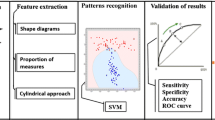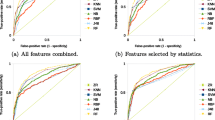Abstract
This paper analyzes four geostatistical functions—semivariogram, semimadogram, covariogram, and correlogram—with the purpose of characterizing lung nodules as malignant or benign in computerized tomography images. The tests described in this paper were carried out using a sample of 30 nodules, 24 benign and 6 malignant. Stepwise discriminant analysis was used to determine which combination of measures were best able to discriminate between the benign and malignant nodules. Then, a linear discriminant analysis procedure was performed using the selected features to evaluate the ability of these features to predict the classification for each nodule. A leave-one-out procedure was used to provide a less biased estimate of the linear discriminator’s performance. All analyzed functions have value area under receiver operation characteristic (ROC) curve above 0.800, which means results with accuracy between good and excellent. The preliminary results of this approach are very promising in characterizing nodules using geostatistical functions.











Similar content being viewed by others
References
Tarantino AB (1997) In: Doenças Pulmonares (ed) Nódulo solitário do pulmão, 4th edn. Guanabara Koogan, Rio de Janeiro pp 733–753
Gonzalez RC, Woods RE (1992) Digital image processing. 3rd edn. Addison-Wesley, Reading, Massachusetts
Kovalev VA, Kruggel F, Gertz HJ, Cramon DYV (2001) Three-dimensional texture analysis of MRI brain datasets. IEEE Trans Med Imaging 20:424–433
Li X (2001) Texture analysis for optical coherence tomography image. Masters thesis, University of Arizona
Freeborough PA, Fox NC (1998) MR texture analysis to the diagnosis and tracking of Alzheimer’s disease. IEEE Trans Med Imaging 17:475–479
McNitt-Gray MF, Hart EM, Wyckoff N, Sayre JW, Goldin JG, Aberle DR (1999) A pattern classification approach to characterizing solitary pulmonary nodules imaged on high resolution CT: preliminary results. Med Phys 26:880–888
McNitt-Gray MF, Hart EM, Wyckoff N, Sayre JW, Goldin JG, Aberle DR (1999) The effects of co-occurrence matrix based texture parameters on the classification of solitary pulmonary nodules imaged on computed tomography. Comput Med Imaging Graph 23:339–348
Sahine B, Chan HP, Petrick N, Wei D, Helvie MA, Adler DD, Goodsill MM (1996) Classification of mass and normal breast tissue: a convolution neural network classifier with spatial domain and texture images. IEEE Trans Med Imaging 15:598–610
Mudigonda NR, Rangayyan RM, Desautels JEL (2000) Gradient and texture analysis for the classification of mammographic masses. IEEE Trans Med Imaging 19:1032–1043
Galloway MM (1975) Texture analysis using gray level run lengths. Comput Graph Image Processing 4:172–179
Ferreyra R, Apezteguia H, Sereno R, Jones J (2002) Reduction of soil water spatial sampling density using scaled semivariograms and simulated annealing. Geoderma 110:265–289
Bruniquel-Pinel V, Gastellu-Etchegorry JP (1998) Sensitivity of texture of high resolution images of forest to biophysical and acquisition parameters. Remote Sensing Environ 65:61–85
Carr JR, de Miranda FP (1998) The semivariogram in comparison to the co-occurrence matrix for classification of image texture. IEEE Trans Geosci Remote Sensing 36:1945–1952
Goodin D, Henebry GM (1998) Variability of spectral reflectance and vegetation indices in tallgrass prairie: spatio-temporal analysis using semivariograms and close-range remote sensing. In: Proceedings of the IEEE international geoscience and remote sensing symposium (IGARSS’98), vol 2, Seattle, Washington, July 1998, pp 825–827
Goodin D, Gao J, Henebry GM (2004) The effect of solar illumination angle and sensor view angle on observed patterns of spatial structure in tallgrass prairie. IEEE Trans Geosci Remote Sensing 42:154–165
Dai X, Khorram S (1998) The effects of image misregistration on the accuracy of remotely sensed change detection. IEEE Trans Geosci Remote Sensing 36:1566–1577
Chica-Olmo M, Abarca-Hernandez F (2000) Computing geostatistical image texture for remotely sensed data classification. Comput Geosci 26:373–383
Toshioka S, Kanawawa K, Niki N (1997) Computer aided diagnosis system for lung cancer based on helical CT images. Proc Med Imaging SPIE 3034:975–984
Kawata Y, Niki N, Ohmatsu H, Kusumoto M, Kakinuma R, Mori K, Nishiyama H, Eguchi K, Kaneko M, Moriyama N (1999) Computer aided differential diagnosis of pulmonary nodules using curvature based analysis. In: Proceedings of the international conference on image analysis and processing, vol 2, Venice, Italy, September 1999. IEEE Computer Society Press, Washington, DC, pp 470–475
Silva AC, Carvalho PCP, Gattass M (2003) Investigaçãode métodos estatísticos baseados em textura 3D para diagnóstico de nódulo pulmonar em imagens de tomografia computadorizada. In: III Workshop de Informática Médica, Fortaleza
Clunie DA (2000) DICOM structured reporting. PixelMed Publishing, Pennsylvania
Nikolaidis N, Pitas I (2001) 3-D image processing algorithms. Wiley, New York
Silva AC, Carvalho PCP (2002) Sistema de análise de nódulo pulmonar. In: II Workshop de Informática aplicada a saúde, Itajai, Universidade de Itajai. Available at http://www.visgraf.impa.br/Projects/vismed/lung/doc1/CBComp2002.pdf.
Clark I (1979) Practical geostatistics. Applied Science Publishers, London
Cressie NAC (1993) Statistical for spatial data. Wiley, New York
Journel AG, Huijbregts CJ (1978) Mining geostatistics. Academic Press, London
Lachenbruch PA (1975) Discriminant analysis. Hafner Press, New York
Fukunaga K (1990) Introduction to statistical pattern recognition, 2nd edn. Academic Press, London
Erkel ARV, Pattynama PMT (1998) Receiver operating characteristic (ROC) analysis: basic principles and applications in radiology. Eur J Radiol 27:88–94
Technologies L (2003) SPSS 11.0 for Windows. Available at http://www.spss.com
Metz CE (2003) ROCKIT software. Available at http://xray.bsd.uchicago.edu/krl/KRL_ROC/software_index.htm
Deutsch CV, Journel AG (1992) GSLIB: geostatistical software library and user’s guide. Oxford University Press, New York
Greinera M, Pfeifferb D, Smithc R (2000) Principles and practical application of the receiver-operating characteristic analysis for diagnostic tests. Prev Vet Med 45:23–41
Acknowledgments
We would like to thank CAPES and FAPERJ for the financial support, Dr. Rodolfo A. Nunes and his team for the clinical support, and the staff from Instituto Fernandes Figueira, particularly Dr. Marcia Cristina Bastos Boechat, for the images provided.
Author information
Authors and Affiliations
Corresponding author
Rights and permissions
About this article
Cite this article
Silva, A.C., Carvalho, P.C.P. & Gattass, M. Analysis of spatial variability using geostatistical functions for diagnosis of lung nodule in computerized tomography images. Pattern Anal Applic 7, 227–234 (2004). https://doi.org/10.1007/s10044-004-0219-0
Received:
Accepted:
Published:
Issue Date:
DOI: https://doi.org/10.1007/s10044-004-0219-0




